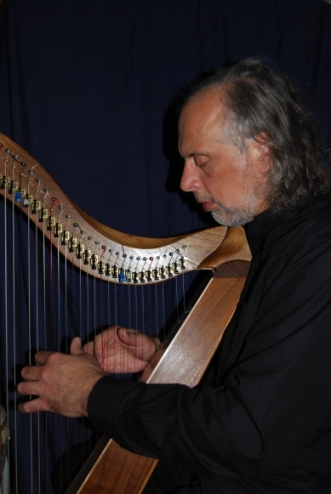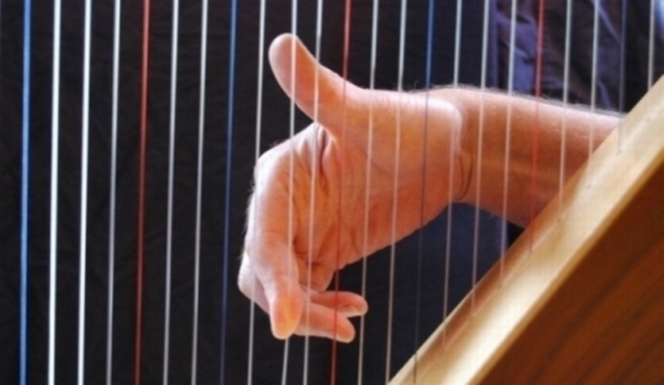TUNING YOUR CELTIC HARP
WITHOUT AN ELECTRONIC DEVICE
INTRODUCTION
I began playing the Celtic harp in 1997, after playing the piano most of my life. When I purchased the harp, I also purchased a strobe tuner, presumably to find an A440, and then to use that strobe as an aid for learning to tune. I then began to notice that a great number of people who play folk instruments rely completely on their strobe tuners. Because I found harp strings more difficult to tune than piano strings, I straddled the fence for awhile, and then I was fortunate enough to have a few lessons with William Jackson, the great Celtic harpist who lives in Asheville, NC. In one of my lessons, Mr. Jackson was clear and to the point: Get rid of your electronic tuner—tune your harp by ear, and only by ear. From that lesson on, I never used my strobe tuner again, in fact I have no idea where it is. All I use for a reference is my metronome, which has an A440 on it, or I use a piano as a reference. At any rate, one note is all I need, and all I want. I encourage all of you to work toward that goal as well.
Learning to tune is difficult, but very rewarding. Not all harps are the same, and you may need to make slight variations in the tempered scale that are unique to the harp you are playing. The issue of false beats also plays a role in how you tune. Tuning by ear will help
you to accomodate all these issues better, and help you to give your harp the sound you want.

What is A440?
The first thing we need to understand is A440, then we need to understand equal-tempered tuning, and after that it's mostly practice. A440 is the agreed upon frequency for A6, or the A above middle C on the piano. Musicians all over the world agree that a perfect A6 beats at 440 times per second, no more, no less. Unless you have amazing perfect pitch like our Selkie fiddle player Christina DeCiantis, you need to start your tuning by finding that pitch from an outside source. Some piano tuning forks are tuned to C, sometimes you may be attempted to get an E from the first of the guitar open strings, but A6 is by far the best pitch to start with. You're about to find out that tuning a fixed-stringed instrument is a compromise, and the only note that is really perfectly in tune is your first note, and the notes an octave above or below that. So you need to start with the note that string players and oboe players start with. Then you'll always be assured of getting off with a good start.
FINDING A440

All right, you've found a way to get an A440—so what do you do with it? Play the comparable A on your harp. For now I'll assume you're using a metronome that plays a perfect A440. Listen to the two sounds together. If your harp is extremely flat, the two will sound like mush.
Now begin to change the string tension with your tuning wrench until the two become more aligned. If the string started out flat, which it will almost always be, then tighten the string with a clockwise motion of your wrench. If the harp is very cold it might be sharp, but that is more rare. Be sure you turn the correct way, or you could end up with a broken string. As you get closer to the right place, you will start hearing the ubiquitous "beats"—the phenomenon that anyone who tunes an instrument knows very well. They will start out fast, and as you get closer they will slow down. Any two pitches that are slightly out of tune will form these beats, and once you hear them, it's easy to correct them—just make them stop. When they stop, you're in tune. This is in some ways the most difficult part of the process. It's more difficult to listen for out of phase pitches from two dissimilar instruments. If you feel uncomfortable the first time you try this, then try "checking" with your strobe tuner—you know the item you're going to throw out in a couple of weeks. If the needle lines up correctly, then you were successful. Once you perform this portion successfully, stay independent of the strobe tuner. You need to get rid of your crutch as quickly as possible.
TUNING TECHNIQUES
VERY IMPORTANT—The more subtle your input, the more stable the tuning. If you wildly turn the string up and down, it will not set in place very well. Turn it carefully and slowly. When I tune a piano, I usually tune the strings slightly sharp, and then back down into the pitch. That helps stabilize harp tuning as well. Notice I said slightly sharp—that means very slightly sharp. Making a bad mistake toward the sharp end obviously carries a higher immediate penalty than going too far the other way. However, relaxing an already taut string too much can also make that string subject to breaking at a later date (such as during a concert). You want to get your strings in place and keep them there as much as possible. They should never go more than a half step either way, and that's a wide range.
RELATIVE PITCH—I'm assuming that your relative pitch is good enough so that you know approximately where the string should be, and whether it's too high or low. The discussion here is for FINE tuning. You need some concept of relative pitch to keep from breaking strings, however. An awareness of intervals is important, and if you feel lacking here, I would recommend developing this area with a good voice or piano teacher.
PYTHAGORAS AND THE PHYSICS OF SOUND
Now that you know how to find A440 without breaking your string, and you understand relative pitch, you are ready to start tuning one string against another, a process you will
understand better with a little knowledge of history. Although some cultures were experimenting with string ratios many thousands of years ago, most people point to Pythagoras as the groundbreaker for our present knowledge of string relationships and tuning. His system was far from perfect, but his brilliance in the fields of music and math were unmatched in his time, and most other times as well. Pythagoras believed that everything in the universe—physical, mental and spiritual—revolved around math. He observed that the longer a string, the lower its pitch, in fact he noticed that a string that is twice as long as another string is an octave lower (assuming the same tension). He didn't know about frequency, but his observation here was exactly right.
When a performer plays a string, the kinetic energy causes the string to move back and forth to the fullest extent of its capabilities. A long string therefore has a bigger distance to travel, and therefore must repeat its cycle at a slower rate than a short string, which can move back and forth more quickly. I'm sure Pythagoras noted that when two strings were almost an octave a part, they began to manifest "beats", and when they become exactly an octave apart, the beats stopped. One can see why Pythagoras found numbers to be so signficant—this is an amazing phenomenon.
Pythagoras didn't stop here—When the A harp string goes up a perfect fifth to E, that E should vibrate at a pitch ratio of 3/2 (660 to 440), or in Pythagoras' understanding, the A should be 3/2 times longer than the E. For people in Pythagoras' time to hear a nice 5th with no beats, and octaves with no beats, they set up a mathematical system of pitches that made an entire scale. I won't go into the whole system here—I love math but I've found most people don't. Please email if you're curious about the whole scale, or read more about this fascinating subject.
Here's where your knowledge about Pythagoras comes into play. Without going into the mathematical ratios, there is an error in Pythagoras' system. In a fixed-string system (harp, piano, guitar), you can't "have your cake and eat it too." You can't have your fifths and octaves in tune, and then expect the rest of the intervals to work. They don't. If you strive to make your fifths perfectly in tune, your first few notes will sound great, but there will be trouble ahead. This is especially true on a piano, where you have a chromatic scale (the harp has only the diatonic scale). Therefore we have to compromise. The basic principle is this: Contract fifths (very slightly), expand fourths, and make octaves perfectly in tune. As you do this, you'll be creating an equal-tempered scale. The rest of the intervals will fall into line, and you can use them to check your work. If you listen to a major third on a finely-tuned piano, you will notice it has about seven beats per second. Your harp needs to sound the same. If you will use the system I will show you know, you can use one interval to check the other. You can make mistakes along the way, and then find them by checking with other intervals. This is a fool-proof method.
Note that from the time of Pythagoras until the early 1700's, musicians wrestled with the problems manifested in fixed-string tuning. As a result, music stayed in a few diatonic keys, and rarely ventured into chromaticism (especially for fixed-string instruments). Because of the advent of well-tempered tuning, composers could write in any key. This is why JS Bach composed his famous Well-Tempered Clavier. It is a prelude and fugue in every key, and it was a champion of the new system of tuning. Well-tempered tuning became equal-tempered tuning, the system you're about to learn. Now that we've had enough of history and science, let's learn to tune.
Go to Page 2

